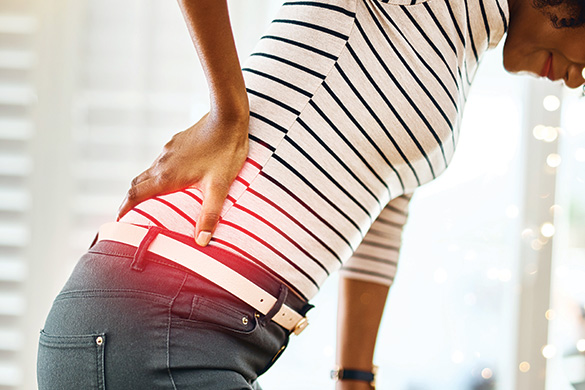Aches and Pains at Midlife

Getting out of bed before daylight or out of a car after a 12-hour trip is tough for practically everybody. Now couple that with a stiff back or sore knees, and the movement becomes even more challenging.
Aging doesn’t just mean we add more candles to birthday cakes; our bones, joints and muscles age, too. Our bodies experience more aches and pains than our younger selves. And for many, health takes a back seat. Perhaps we eat too many processed foods and fewer fruits and vegetables, slouch when seated and forego exercise.
“At midlife, we see a lot of men and women struggling with low back, knee and neck pain,” said Nathan Timmer, MD, family physician at Access Health — Mitchell and Avera Medical Group Family Health Center. “This pain is commonly caused by overuse, conditions such as arthritis, or strained and pulled muscles.”
You can try simple solutions to address your pain as well as any inflammation:
- Applying hot or cold compress to the affected area
- Taking over-the-counter medication, such as Tylenol, Aleve or ibuprofen
- Gently stretching or massaging painful joints or muscles
To get the best effective results, do these non-invasive solutions regularly; it requires dedication!
If pain has slowed you down for two weeks or more — ahem, months — it’s time to see a doctor. He or she may recommend continuing some of the noninvasive methods just mentioned, as well as a few added measures. The physician may start a series of injections or sessions with a physical therapist.
When injections, physical therapy or medications are no longer effective, your physician may suggest surgery — joint preservation or joint replacement.
Patients who are younger than age 60 may be best suited with a joint-preserving surgical procedure called arthroscopy,” said Daniel Lister, MD, orthopedic surgeon at Avera Orthopedics – Marshall.
During a minimally invasive procedure, damaged cartilage is either repaired or removed from the space between two bones through a couple of small incisions.
Older adults in their 60s or 70s may not benefit from an arthroscopic procedure. At this point, a partial or total joint replacement can be considered, depending on severity. Just like arthroscopy, minimally invasive options are available, including joint replacement surgery.
Accurate and minimally invasive techniques allow most people to go home in a day after surgery as well as return to daily activities within a few weeks.
If you’re a younger adult — or trying to slow down or reverse orthopedic pain — take action now.
- Lose weight or maintain your healthy weight to alleviate stress on bones and joints. “Reaching a healthy weight not only reduces your risk of musculoskeletal conditions, but also many diseases including cancer and heart disease,” said Lister.
- Replace processed foods with fruits and vegetables to relieve inflammation. Perhaps add jalapeños to more dishes; eating spicy foods regularly desensitizes nerves which lessens pain, said Timmer.
- Exercise. “Regular exercise supports your bones, muscles and joints by increasing your strength and flexibility,” said Lister. Timmer added, “Remaining sedentary can accelerate arthritis because the fluid in the joints becomes stagnant.” Non-impact exercise, such as walking or swimming, is easy on painful joints.
- Sit up straight. How many times do you look down at your cell phone? Addiction to technology, especially smartphones, strains your back over time. Resist looking at your phone every few minutes. Also, don’t forget to sit up straight at your desk.
If you notice discomfort starting to creep into daily activities, slow down and make it a priority to address the needs of your body. There are options for all degrees of pain. You only get one life; choose to live yours with less pain.
Talk to your health care provider about ongoing pain and how to manage your health.


